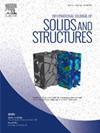Design and sound absorption analysis of labyrinthine acoustic metamaterials based on fractal theory
IF 3.4
3区 工程技术
Q1 MECHANICS
International Journal of Solids and Structures
Pub Date : 2024-10-28
DOI:10.1016/j.ijsolstr.2024.113121
引用次数: 0
Abstract
Acoustic metamaterials exhibit exceptional sound absorption capabilities. This study introduces a fractal labyrinthine acoustic metamaterial (FLAM) designed for sound absorption analyses in a low-frequency range of 1–2000 Hz. The fractal curve is constructed through side substitution on an isosceles right triangle, which is chosen as the spatial recursive substructure due to its self-similarity. The FLAM model is then developed. With the thermal viscous losses considered in narrow channels, the sound absorption coefficient of this model is theoretically analyzed as the structural parameters significantly affect the sound absorption. A comprehensive analysis of low-frequency sound absorption performance is conducted for the first three orders, and the reconstruction of the structure with different combinations of fractal orders is examined to optimize the FLAM. The results show that the proposed FLAM achieves nearly perfect absorption in the 50–400 Hz range, with peak absorption coefficients of 0.99, 0.95, and 0.95 for the first three orders. The proposed FLAMs for the first three orders have total thicknesses of , , and , demonstrating excellent low-frequency sound absorption at deep sub-wavelength scales.
基于分形理论的迷宫式声学超材料的设计与吸声分析
声超材料具有卓越的吸声能力。本研究介绍了一种分形迷宫式声学超材料(FLAM),设计用于 1-2000 Hz 低频范围内的吸声分析。分形曲线是通过对等腰直角三角形进行边置换而构建的,由于其自相似性,我们选择等腰直角三角形作为空间递归子结构。然后建立 FLAM 模型。考虑到窄通道中的热粘性损失,对该模型的吸声系数进行了理论分析,因为结构参数对吸声有显著影响。对前三阶的低频吸声性能进行了综合分析,并研究了不同分形阶数组合的结构重构,以优化 FLAM。结果表明,所提出的 FLAM 在 50-400 Hz 范围内实现了近乎完美的吸声效果,前三阶的吸声系数峰值分别为 0.99、0.95 和 0.95。所提出的前三阶 FLAM 的总厚度分别为 0.032λ、0.021λ 和 0.019λ,显示了在深亚波长尺度上出色的低频吸声性能。
本文章由计算机程序翻译,如有差异,请以英文原文为准。
求助全文
约1分钟内获得全文
求助全文
来源期刊
CiteScore
6.70
自引率
8.30%
发文量
405
审稿时长
70 days
期刊介绍:
The International Journal of Solids and Structures has as its objective the publication and dissemination of original research in Mechanics of Solids and Structures as a field of Applied Science and Engineering. It fosters thus the exchange of ideas among workers in different parts of the world and also among workers who emphasize different aspects of the foundations and applications of the field.
Standing as it does at the cross-roads of Materials Science, Life Sciences, Mathematics, Physics and Engineering Design, the Mechanics of Solids and Structures is experiencing considerable growth as a result of recent technological advances. The Journal, by providing an international medium of communication, is encouraging this growth and is encompassing all aspects of the field from the more classical problems of structural analysis to mechanics of solids continually interacting with other media and including fracture, flow, wave propagation, heat transfer, thermal effects in solids, optimum design methods, model analysis, structural topology and numerical techniques. Interest extends to both inorganic and organic solids and structures.

 求助内容:
求助内容: 应助结果提醒方式:
应助结果提醒方式:


